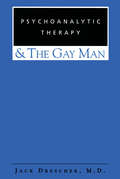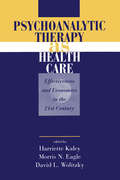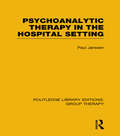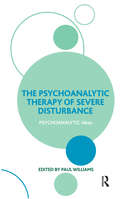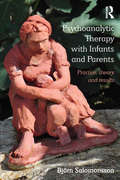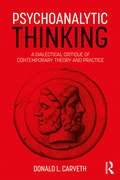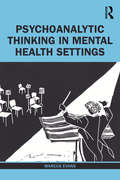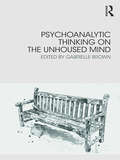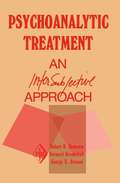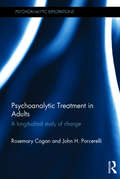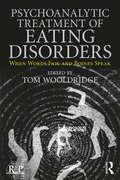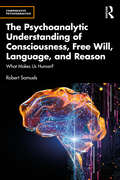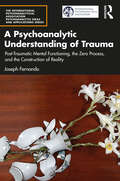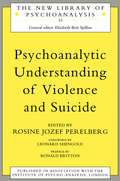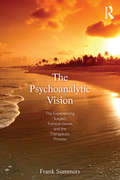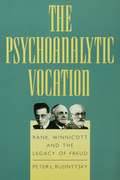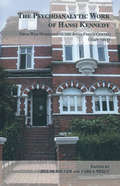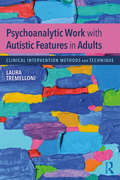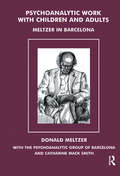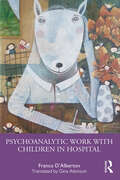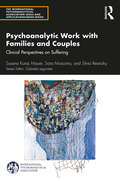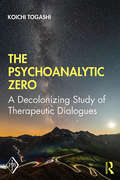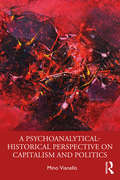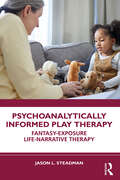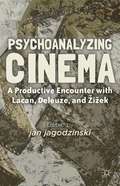- Table View
- List View
Psychoanalytic Therapy and the Gay Man
by Jack DrescherDo the conventional insights of depth psychology have anything to offer the gay patient? Can contemporary psychoanalytic theory be used to make sense of gay identities in ways that are helpful rather than hurtful, respectful rather than retraumatizing? In Psychoanalytic Therapy and the Gay Man Jack Drescher addresses these very questions as he outlines a therapeutic approach to issues of sexual identity that is informed by traditional therapeutic goals (such as psychological integration and more authentic living) while still respecting, even honoring, variations in sexual orientation. Drescher's exploration of the subjectivities of gay men in psychoanalytic psychotherapy is more than a long-overdue corrective to the inadequate and often pathologizing tomes of traditional psychoanalytic writers. It is a vitally human testament to the richly varied inner experiences of gay men. Drescher does not assume that sexual orientation is the entire or even major focus of intensive psychotherapy. But he does argue, passionately and convincingly, that issues of sexual identity - which encompass a spectrum of possibilities for any gay man - must be addressed in an atmosphere of honest encounter that allows not only for exploration of conflict and dissociation but also for restitutive confirmation of the patient's right to be himself. Through its abundance of first-person testimony from both clinical and literary sources, Psychoanalytic Therapy and the Gay Man provides the reader with an unforgettable grasp of what it is like to discover that one is gay in our society and then to find the courage and humanity to live with that knowledge. Any mental health professional - regardless of his or her sexual orientation - who wishes to deal therapeutically with gay men will find Drescher's work indispensable. But it will also be compelling reading for anyone seeking psychological insight into gay men's lives and concerns.
Psychoanalytic Therapy as Health Care: Effectiveness and Economics in the 21st Century
by Morris N. Eagle David L. Wolitzky Harriette KaleyIn Psychoanalytic Therapy as Health Care, a timely and trenchant consideration of the clash of values between managed care and psychoanalysis, contributors elaborate a thoughtful defense of the therapeutic necessity and social importance of contemporary psychoanalytic and psychodynamic approaches in the provision of mental health care. Part I begins with the question of where psychoanalytic treatments now stand in relation to health care; contributors offer explanations of the current state of affairs and consider possible directions of future developments. Part II looks directly at the conundrums that have resulted from the attempt to integrate psychotherapy and managed care, with contributors examining the ethical and legal dimensions of confidentiality, privacy, and reporting to third parties. Part III opens to wider consideration of the experiences of psychoanalysts under health care systems throughout the world. Finally, Part IV demonstrates the relevance of contemporary psychoanalytic approaches to a variety of contemporary patient populations, with contributors focusing on the applicability of analytically oriented treatment to AIDS patients, seriously disturbed young adults, and inner-city clinic patients. Collectively, the contributors to Psychoanalytic Therapy as Health Care convincingly refute the claim that psychoanalytically informed therapy is an esoteric treatment suited only to the "worried well." Drawing on a wide range of clinical and empirical evidence, they forcefully argue that contemporary psychoanalytic approaches are applicable to seriously distressed persons in a variety of treatment contexts. Failure to include such long-term therapies within health care delivery systems, they conclude, will deprive many patients of help they need - and help from which they can benefit in enduring ways that far transcend the limited treatment goals of managed care.
Psychoanalytic Therapy in the Hospital Setting (Routledge Library Editions: Group Therapy)
by Paul L. JanssenThough the impetus for psychoanalytic and group-analytic inpatient psychotherapy largely came from Britain, it was in Germany that this work was supported, developed and researched to a greater extent than elsewhere. Originally published in English for the first time in 1994, Paul Janssen describes the different models which had been tried and evaluated and explains his own integrative model in detail, illustrating it with vivid clinical vignettes. The author also shows that inpatient groups are particularly effective in the treatment of severe personality disorders, borderline conditions and psychosomatic illness. This book will still be valuable reading for psychiatrists, psychotherapists, nurses, social workers and anyone working in healthcare today.
The Psychoanalytic Therapy of Severe Disturbance (The\psychoanalytic Ideas Ser.)
by Paul WilliamsThis book presents the proceedings of the of the conference on the Psychoanalytic Therapy of Severe Disturbance held in Belfast in June 2008. The aim of the conference was to offer a state of the art communication of the key psychoanalytic thinking and approaches to the conceptualisation and treatment of severe disturbance. The result of a unique gathering of the most eminent psychoanalysts in the field with insights into their work on personality disorder, psychotic states and the nature and function of suicidal ideation.This book will be of interest to mental health professionals - psychiatrists, psychoanalysts, psychotherapists, psychologists, social workers and nurses who have an interest in psychoanalysis and psychotherapy.
Psychoanalytic Therapy with Infants and their Parents: Practice, Theory, and Results
by Björn SalomonssonPsychoanalytic Therapy with Infants and Parents provides a clear guide to clinical psychoanalytic work with distressed babies and unhappy parents, a numerous clinical group so often in need of urgent help. Although psychoanalytic work is primarily verbal, and infants may have limited language, this form of treatment is receiving increased attention among therapists. Björn Salomonsson explores how such work can be possible and benefit infants, how to work with the parents (especially the mother), and how major psychoanalytic concepts such as primal repression, infantile sexuality and transference can be worked with and understood in these therapies. Björn Salomonsson argues that attachment concepts, though important, cannot solely help explain everyday problems with breastfeeding, sleeping, and weaning, or more recalcitrant interaction disorders. He shows how we also need psychoanalytic concepts to better understand, not only such "baby worries", but also adult clients' non-verbal communications and interactions. Throughout, he uses extensive practice-based examples and also refers to his research which provides evidence for the effectiveness of this practice. Psychoanalytic Therapy with Infants and Parents provides a unique perspective on working psychoanalytically with parents and infants. This book will be essential reading for psychoanalysts and therapists working with children as well as adults.
Psychoanalytic Thinking: A Dialectical Critique of Contemporary Theory and Practice (Psychological Issues)
by Donald L. CarvethA video of Don Carveth discussing the book and its subject matter can be accessed using the following web URL: https://www.youtube.com/watch?v=yW7tGq0uEtU Since the classical Freudian and ego psychology paradigms lost their position of dominance in the late 1950s, psychoanalysis became a multi-paradigm science with those working in the different frameworks increasingly engaging only with those in the same or related intellectual "silos." Beginning with Freud’s theory of human nature and civilization, Psychoanalytic Thinking: A Dialectical Critique of Contemporary Theory and Practice proceeds to review and critically evaluate a series of major post-Freudian contributions to psychoanalytic thought. In response to the defects, blind spots and biases in Freud’s work, Melanie Klein, Wilfred Bion, Jacques Lacan, Erich Fromm, Donald Winnicott, Heinz Kohut, Heinrich Racker, Ernest Becker amongst others offered useful correctives and innovations that are, nevertheless, themselves in need of remediation for their own forms of one-sidedness. Through Carveth’s comparative exploration, readers will acquire a sense of what is enduringly valuable in these diverse psychoanalytic contributions, as well as exposure to the dialectically deconstructive method of critique that Carveth sees as central to psychoanalytic thinking at its best. Carveth violates the taboo against speaking of the Imaginary, Symbolic and the Real unless one is a Lacanian, or the paranoid-schizoid and depressive positions unless one is a Kleinian, or id, ego, superego, ego-ideal and conscience unless one is a Freudian ego psychologist, and so on. Out of dialogue and mutual critique, psychoanalysis can over time separate the wheat from the chaff, collect the wheat, and approach an ever-evolving synthesis. Psychoanalytic Thinking: A Dialectical Critique of Contemporary Theory and Practice will be of great interest to psychoanalysts and psychoanalytic psychotherapists and, more broadly, to readers in philosophy, social science and critical social theory.
Psychoanalytic Thinking in Mental Health Settings
by Marcus EvansThis book demonstrates the use of psychoanalytic thinking in front-line mental health settings and aims to make an approach to working with emotional and mental disturbance available to a wide range of clinicians within psychiatric and other mental health settings. Rooted in the author’s extensive clinical experiences, the approach explored in this book applies psychoanalytic thinking and discusses this in relation to the mental health conditions regularly encountered in psychiatric settings, such as Schizophrenia, Manic Depression, Psychotic Depression, Anorexia, Deliberate Self Harm, and Personality Disorder. The book therefore provides valuable and practical ways of working with these difficult, complex, and problematic conditions. It further makes sense of the relationships and emotions encountered when working in these settings and introduces possibilities for more effective and rewarding ways of working, including a model of support through supervision, reflective practice, and clinical discussion. Illustrated by clinical examples from more than four decades of experience in the field, this book is ideal for the interested mental health practitioner.
Psychoanalytic Thinking on the Unhoused Mind
by Gabrielle BrownPsychoanalytic Thinking on the Unhoused Mind illuminates the psychological underpinnings of current societal problems: homelessness, mental distress, loneliness and states of societal breakdown and exclusion. Illustrated with a broad range of clinical work as well as thoughts on art and literature, the book brings to life complex tensions between the individual psyche, the group, and wider political and cultural structures. ‘Unhoused’ states of mind are explored in rough sleepers, ex-prisoners, survivors of institutional abuse and family trauma, and people living with personality disorder, addiction, psychosis and dementia. Chapters describe outreach, assessment and long-term psychotherapy, as well as reflective practice with staff teams and care systems, and learning from consultation, supervision and policy development. New therapeutic responses to chronic risk and to resilience are developed from psychoanalytic understandings of difficulties with containment and care. The collection will be of value to psychotherapists and other mental health practitioners, as well as those working in therapeutic, residential and criminal justice settings and outreach services.
Psychoanalytic Treatment: An Intersubjective Approach (Psychoanalytic Inquiry Book Series)
by Robert D. Stolorow Bernard Brandchaft George E. AtwoodPsychoanalytic Treatment: An Intersubjective Approach fleshes out the implications for psychoanalytic understanding and treatment of adopting a consistently intersubjective perspective. In the course of the study, the intersubjective viewpoint is demonstrated to illuminate a wide array of clinical phenomena, including transference and resistance, conflict formation, therapeutic action, affective and self development, and borderline and psychotic states. As a consequence, the authors demonstrate that an intersubjective approach greatly facilitates empathic access to the patient's subjective world and, in the same measure, greatly enhances the scope and therapeutic effectiveness of psychoanalysis. Psychoanalytic Treatment is another step in the ongoing development of intersubjectivity theory, as born out in Structures of Subjectivity (1984), Contexts of Being (1992), and Working Intersubjectively (1997), all published by the Analytic Press
Psychoanalytic Treatment in Adults: A longitudinal study of change (Psychoanalytic Explorations)
by Rosemary Cogan John H. PorcerelliThe outcomes of psychoanalysis, as with other psychotherapies, vary considerably. Psychoanalytic Treatment in Adults examines the results of a longitudinal study of change during psychoanalysis, illuminating the characteristics of patients, analysts and analyses which can help to predict outcomes of treatment. Written by experienced psychologists and psychoanalysts, chapters in the book draw upon sixty case studies to consider how patients with very different analytic outcomes respond at both the beginning and end of their analysis. Psychoanalysts used a clinician report measure, the Shedler-Westen Assessment Procedure, to describe a patient at the beginning of psychoanalysis and every six months until the analysis ended. This allowed the authors to learn about changes over analysis and, in turn, improved treatment planning and practice for the well-being of other patients. Chapters explore five outcomes: a negative therapeutic reaction; attrition when the patient drops out; attrition due to external events; mutual agreement between patient and analyst without maximum benefits; and mutual agreement between patient and analyst with maximum benefits. The findings from these chapters will be of interest to researchers and academics in the fields of psychoanalysis, psychotherapy, psychodynamic therapy, psychoanalytic education, psychiatry and psychology. The results should also help clinicians recognize potential problems early in analytic treatments so that they can work more effectively with patients.
Psychoanalytic Treatment of Eating Disorders: When Words Fail and Bodies Speak (Relational Perspectives Book Series)
by Tom WooldridgePsychoanalytic Treatment of Eating Disorders: When Words Fail and Bodies Speak offers a compilation of some of the most innovative thinking on psychoanalytic approaches to the treatment of eating disorders available today. In its recognition of the multiple meanings of food, weight, and body shape, psychoanalytic thinking is uniquely positioned to illuminate the complexities of these often life-threatening conditions. And while clinicians regularly draw on psychoanalytic ideas in the treatment of eating disorders, many of the unique insights psychoanalysis provides have been neglected in the contemporary literature. This volume brings together some of the most respected clinicians in the field and speaks to the psychoanalytic conceptualization and treatment of eating disorders as well as contemporary issues, including social media, pro-anorexia forums, and larger cultural issues such as advertising, fashion, and even agribusiness. Drawing on new theoretical developments, several chapters propose novel models of treatment, whereas others delve into the complex convergence of culture and psychology in this patient population. Psychoanalytic Treatment of Eating Disorders will be of interest to all psychoanalysts and psychotherapists working with this complex and multi-faceted phenomenon.
The Psychoanalytic Understanding of Consciousness, Free Will, Language, and Reason: What Makes Us Human? (Comparative Psychoanalysis)
by Robert SamuelsThe Psychoanalytic Understanding of Consciousness, Free Will, Language, and Reason examines the ways in which we can use psychoanalysis in order to better understand humanity and explores the question of what makes us human. For thousands of years, thinkers have been trying to define what makes us human. Some of the main questions they have asked is: What is consciousness? Do we have free will? Do animals use language? And what does reason mean? Samuels argues that we need to better understand the psychoanalytic approach to human nature in order to answer these questions, as well as using it to provide a new way of understanding issues such as addiction, political conflict, ideology, and destructive personal relationship. This book will be of vital interest to psychotherapists, as well as students and researchers across the fields of psychoanalysis, philosophy, and psychology.
A Psychoanalytic Understanding of Trauma: Post-Traumatic Mental Functioning, the Zero Process, and the Construction of Reality (The International Psychoanalytical Association Psychoanalytic Ideas and Applications Series)
by Joseph FernandoA Psychoanalytic Understanding of Trauma presents a theory of the nature of trauma and post-traumatic mental functioning based on the concept of the ‘zero process’. Joseph Fernando presents a novel, comprehensive, and clinically useful theory of trauma. The author first presents theories of trauma and describes the zero process, related to the breakdown of various ego functions, such as memory and integration, during trauma. Rather than replacing Freud’s ideas of the primary process and repression, Fernando expands on the idea of the mind to include both types of functioning, identifies how they can be differentiated, and examines the different therapeutic techniques they require. He also considers how trauma impacts the construction of reality, the role of human development, the relation of trauma and borderline disorders, and the development of therapeutic technique. Through the unique illustration and narration of cases of three patients, Fernando presents conceptual and clinical innovations. A Psychoanalytic Understanding of Trauma will be of great interest to psychoanalysts and psychoanalytic psychotherapists in practice and in training.
Psychoanalytic Understanding of Violence and Suicide (The New Library of Psychoanalysis)
by Rosine Jozef PerelbergAlthough there is a vast literature on aggression, comparatively little has been written on the issue of violence and even fewer clinical discussions have been published on the violent patient. This pioneering book presents a collection of case studies on the intensive psychoanalytic treatment of patients who have committed serious acts of violence against themselves or others. Each detailed clinical account demonstrates the effectiveness of the psychoanalytic treatment and furthers our understanding of the nature of violence. The Psychoanalytic Understanding of Violence and Suicide also contains a comprehensive review of the existing literature on aggression and violence from America, England and France, presenting major themes contained in this literature which will be of interest to all those working with violent and suicidal patients.
The Psychoanalytic Vision: The Experiencing Subject, Transcendence, and the Therapeutic Process
by Frank SummersPsychoanalytic therapy is distinguished by its immersion in the world of the experiencing subject. In The Psychoanalytic Vision, Frank Summers argues that analytic therapy and its unique epistemology is a worldview that stands in clear opposition to the hegemonic cultural value system of objectification, quantification, and materialism. The Psychoanalytic Vision situates psychoanalysis as a voice of the rebel, affirming the importance of the subjective in contrast to the culture of objectification. Founded on phenomenological philosophy from which it derives its unique epistemology and ethical grounding, psychoanalytic therapy as a hermeneutic of the experiential world has no role for reified concepts. Consequently, fundamental analytic concepts such as "the unconscious" and "the intrapsychic," are reconceptualized to eliminate reifying elements. The essence of The Psychoanalytic Vision is the freshness of its theoretical and clinical approach as a hermeneutic of the experiential world. Fundamental clinical phenomena, such as dreams, time, and the experience of the other, are reformulated, and these theoretical shifts are illustrated with a variety of vivid case descriptions. The last part of the book is devoted to the surreptitious role beliefs and values of contemporary culture play in many forms of psychopathology. For clinicians, The Psychoanalytic Vision offers a fresh clinical theory based on the consistent application of the subjectification of human experience, and for scholars, a worldview that provides the framework for a potentially fruitful cross-fertilization of ideas with cognate disciplines.
The Psychoanalytic Vocation: Rank, Winnicott, and the Legacy of Freud
by Peter L. RudnytskyObject relations, which emphasizes the importance of the preoedipal period and the infant-mother relationship, is considered by many analysts to be the major development in psychoanalytic theory since Freud. In this reinterpretation of its history Peter L. Rudnytsky focuses on two pivotal figures: Otto Rank, one of Freud's original and most brilliant disciples, who later broke away from psychoanalysis, and D. W. Winnicott, the leading representative of the Independent tradition in British psychoanalysis. Rudnytsky begins with an overview arguing that object relations theory can synthesize the scientific and hermeneutic dimensions of psychoanalysis. He the uses the ideas of Rank and Winnicott to uncover the preoedipal aspects of Sophocles' Oedipus the King. After an appraisal of the relationship between Rank and Freud, he turns to Rank's neglected writings between 1924 and 1927 and shows how they anticipate contemporary object relations theory. Rudnytsky critically measures Winnicott's achievement against those of Heinz Kohut and Jacques Lacan, the founders of two competing schools of psychoanalysis, and compares Winnicott's life and work with Freud's. Next, using both published and unpublished accounts by the psychotherapist Harry Guntrip of his analyses with W. R. D. Fairbairn and Winnicott, he probes the personal and intellectual interactions among these three British clinicians. Rudnytsky concludes by advancing a psychoanalytic theory of the self as a rejoinder to the postmodernism that is the dominant ideology in literary studies today. In two appendices he makes available for the first time an English translation of Rank's "Genesis of the Object Relation" and a 1983 interview with Clare Winnicott.
The Psychoanalytic Work of Hansi Kennedy: From War Nurseries to the Anna Freud Centre (1940-1993)
by Jill M. Miller Carla NeelyThis book presents a selection of the works of Hansi Kennedy, preeminent child psychoanalyst, whose career began with Anna Freud in the Hampstead War Nurseries and continued at the Hampstead Child Therapy Clinic (renamed the Anna Freud Centre in 1982) until retirement in 1993. Her career spanned a significant period in the development of child psychoanalysis, as her ideas foreshadowed a number of advances in theory during the period which have had a profound impact on child psychoanalytic technique.
Psychoanalytic Work with Autistic Features in Adults: Clinical Intervention Methods and Technique
by Laura TremelloniPsychoanalytic Work with Autistic Features in Adults deals with the diagnostic and therapeutic difficulties of working with patients with autistic residuals, formed in early life experiences that have remained dormant in the unconscious mind. Laura Tremelloni traces the process of identifying them in adult patients, and stresses the need to develop a treatment plan suitable for this kind of pathology. This book uses clinical cases to examine the difficulties of work with hard to reach adults with 'gaps' in their sense of Self and symptoms related to primitive experiences of "non-being". Tremelloni presents new, adaptive therapeutic intervention methods for overcoming such obstacles and identifies the personification and permanence of undeveloped parts of the Self, in hard to reach adults who have otherwise developed satisfactorily and would not be diagnosed as autistic. In such cases, the author suggests the need for clinicians to adapt classic psychoanalytic approaches to the alternating levels of development of the separate parts which the Self has broken into. Psychoanalytic Work with Autistic Features in Adults will help clinicians in psychoanalysis and psychoanalytic psychotherapy to more effectively reach such patients, whilst attempting to address the problematic limitations of therapeutic techniques in very difficult clinical cases.
Psychoanalytic Work with Children and Adults: Meltzer in Barcelona
by Donald MeltzerThis volume is a collection of seminars and lectures the author gave to the Psychoanalytic Group of Barcelona under Dr Leon Grinberg, and later Dr Benito Lopez, during his visit to Barcelona. The clinical case studies outlined in the book address with typical variety the author's thoughts on clinical work with children and adults, and the numerous issues involved therein, including depression, jealousy, delusional omnipotence and perversion.
Psychoanalytic Work with Children in Hospital
by Franco D'AlbertonPsychoanalytic Work with Children in Hospital presents the experiences of a psychoanalyst working within a hospital paediatric department. It explores the possibilities for applying psychoanalytic theory when working with children in hospital and how it can be extended to include parents, caregivers, health care staff and volunteers. Each chapter of the book addresses an issue or area of professional experience that presented Franco D’Alberton with clinical or technical questions, outlining the core concern and then exploring his attempt to provide answers to these questions. This volume presents many possible applications of psychoanalytic theory in a paediatric hospital, encompassing issues encountered by health care staff and volunteers as well as by parents and their hospitalized children, such as physical pain, meetings and information sharing and group settings. It also describes therapeutic interventions directed towards both children and parents. This book will be key reading for child and adolescent psychoanalysts, psychotherapists, and clinical psychologists in practice and in training. It will also interest clinicians seeking to understand how psychoanalytic work can be applied in hospital and health care settings.
Psychoanalytic Work with Families and Couples: Clinical Perspectives on Suffering (The International Psychoanalytical Association Psychoanalytic Ideas and Applications Series)
by Susana Kuras Mauer Sara Moscona Silvia ResnizkyPsychoanalytic Work with Families and Couples rethinks the ways in which conflicts present today in psychoanalytic consulting rooms and the nature of suffering in family, couple, and sibling bonds. Based on two major concepts, that of device (drawn from the philosophers Foucault, Deleuze, and Agamben) and that of link (developed by Berenstein and Puget), the authors have developed new approaches to clinical practice with families and couples that focus on the complexity, singularity, and immanence of patient-analyst interaction in the session. In thinking about link dynamics, moreover, they go beyond the consulting room to reflect on how these dynamics develop in other spaces, such as institutions, organizations, and the fraternal circle of colleagues. Part I, Couples and Families Today, discusses changes undergone by families and couples in the last thirty years and their effects on psychoanalytic practice. Attributing a link logic to suffering and to the situations that condition it implies making significant decisions regarding our clinical strategy, our choice of a device and of an interpretive path. Faithful to the idea that the clinical dimension calls for transformations, the second part, Facing Clinical Challenges, includes clinical materials from manifold treatment devices that attest to changes both in contemporary paradigms and in the professional lives of psychoanalysts. Psychoanalytic Work with Families and Couples will be of great interest to all practicing psychoanalysts and psychoanalytic psychotherapists.
The Psychoanalytic Zero: A Decolonizing Study of Therapeutic Dialogues (Psychoanalytic Inquiry Book Series)
by Koichi TogashiThe Psychoanalytic Zero: A Decolonizing Study of Therapeutic Dialogues is written from the unique perspective of a Western-trained Asian psychoanalyst and applies principles of Eastern philosophy to understand the psychoanalytic relationship, psychoanalytic processes, and their uses—and limitations—for alleviating human suffering. Bringing a unique Eastern perspective to a previously Western-dominated discipline and framed within the current relational and ethical trends in psychoanalysis, the book enables readers to develop a language for understanding an Eastern ethical viewpoint and explore how this language can change our awareness of psychoanalytic practice and human suffering. Chapters are devoted to the Eastern concepts of nothingness, emptiness, surrender, sincerity, silence and narrative, and issues including existential "guilt of being," trauma, contingency, informed consent, the sense of being human, and uncertainty. Discussions are illustrated and illuminated through vivid recreations and careful elaboration of therapeutic case studies with traumatized patients. The studies demonstrate the process by which patients regain a sense of being human. This enriched perspective will, it is hoped, help the analyst treat traumatized patients who are unable to relate to others, and who do not experience themselves as being human. The Psychoanalytic Zero will enrich an analyst’s sensitivity to the appearance of the moment without context—the psychoanalytic zero—which opens infinite opportunities for continued growth in a psychoanalytic relationship. It will be of great appeal to psychoanalysts and psychoanalytic psychotherapists interested in self-psychological, intersubjective, and relational theories.
A Psychoanalytical-Historical Perspective on Capitalism and Politics
by Mino VianelloA Psychoanalytical-Historical Perspective on Capitalism and Politics explores how empathy once shaped the collective unconscious, before being replaced by rampant individualistic drive to power. Mino Vianello uses "radical federalism" to define a new approach to democracy, hoping for an end to the repetition of outdated political and economic ideals to solve the world’s democratic crisis. The book brings together a multitude of disciplines and perspectives, including Marxism, history, class, feminism, politics and empathy, to provide a comprehensive and honest history of power from the Enlightenment to the present day. This interdisciplinary study will be key reading for academics and scholars of Jungian studies, politics, sociology, history and economics.
Psychoanalytically Informed Play Therapy: Fantasy-Exposure Life-Narrative Therapy
by Jason L. SteadmanPsychoanalytically Informed Play Therapy: Fantasy-Exposure Life-Narrative Therapy is a structured manual for the execution of FELT, an integrative play therapy that marries the analytic, relational, and psychodynamic aspects of traditional Play Therapy with the scientific rigor and replicability standards of clinical empiricism.Jason Steadman’s FELT model creates a structured, empirically derived means of monitoring children’s play using psychoanalytic methods. Steadman’s method proposes the usage of story stems to structure play to address critical needs in children’s psychological development. In FELT, Steadman teaches readers how to identify problematic play themes and how to respond therapeutically to drive play and general child development toward healthy directions. Steadman uses anxiety as the primary example of psychological distress for FELT, but also shows how the method can be applied to many other pathologies, such as depression and trauma. Steadman explains 11 core FELT themes, which are then further condensed to three major clinical targets identified in the play of clinically anxious children. Each of these is described in detail in the book and therapists are shown not only how to reliably identify themes, but how to focus their interventions to move children toward major play-based targets. Integrating psychoanalytic theory with an emphasis on Object Relations, Steadman’s FELT program highlights the importance of the self in healthy child development and how play-based psychotherapy can be used to help children build stronger, healthier selves that can face a wide variety of psychological issues across their lifespan.Including comprehensive theoretical underpinnings and thorough clinical examples of FELT at work, this volume will allow therapists, clinicians, and mental health workers to understand childhood play in an empirically based manner and show them how to integrate the key tenets of FELT into their own work to better aid children experiencing anxiety and other mental health concerns.
Psychoanalyzing Cinema
by Jan JagodzinskiThe essays within this collection explore the possibilities and potentialities of all three positions, presenting encounters that are, at times contradictory, at other times supportive, as well as complementary. The collection thereby enriches the questions that are being raised within contemporary cinematic studies.
